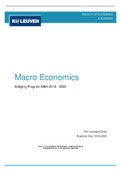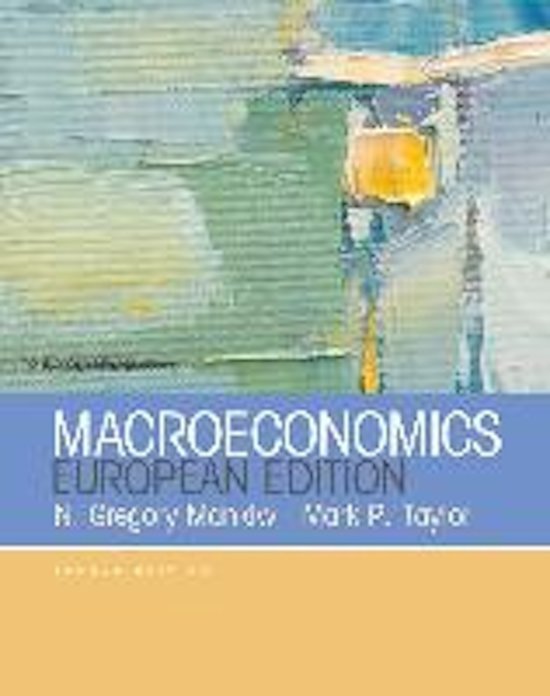FACULTY OF ECONOMICS
& BUSINESS
Macro Economics
Bridging Program MBA 2019 - 2020
Prof. Verhaest Dieter
Academic Year: 2019–2020
FACULTY OF ECONOMICS AND BUSINESS - CAMPUS BRUSSELS
WARMOESBERG 26 – B 1000 BRUSSELS BELGIUM
,MACRO ECONOMIC
1 INTRODUCTION: WHAT IS MACROECONOMICS? ................................................................................................. 2
2 THE DATA OF MACROECONOMICS...................................................................................................................... 4
2.1 MEASURING A NATION’S WELL-BEING (CHAPTER 4)................................................................................................ 4
2.2 MEASURING THE COST OF LIVING (CHAPTER 5) ....................................................................................................... 7
3 THE REAL ECONOMY IN THE LONG RUN .............................................................................................................15
3.1 PRODUCTION AND GROWTH (CHAPTER 6) ............................................................................................................ 15
3.2 UNEMPLOYMENT (CHAPTER 7) .............................................................................................................................. 19
4 INTEREST RATES, MONEY AND PRICES IN THE LONG RUN ...................................................................................27
4.1 SAVING, INVESTMENT, AND THE FINANCIAL SYSTEM (CHAPTER 8) ....................................................................... 27
4.2 THE MONETARY SYSTEM (CHAPTER 11) ................................................................................................................. 29
4.3 MONEY GROWTH AND INFLATION (CHAPTER 12).................................................................................................. 33
5 THE MACROECONOMICS OF OPEN ECONOMIES .................................................................................................43
5.1 OPEN-ECONOMY MACROECONOMICS: BASIC CONCEPTS (CHAPTER 13) .............................................................. 43
6 SHORT-RUN ECONOMIC FLUCTUATIONS ............................................................................................................50
6.1 BUSINESS CYCLES (CHAPTER 15) ............................................................................................................................ 50
6.2 KEYNESIAN ECONOMICS AND IS-LM ANALYSIS (CHAPTER 16) ............................................................................... 51
6.3 AGGREGATE DEMAND AND AGGREGATE SUPPLY (CHAPTER 17)........................................................................... 63
6.4 THE INFLUENCE OF MONETARY AND FISCAL POLICY ON AGGREGATE DEMAND (CHAPTER 18)............................ 73
6.5 THE SHORT-RUN TRADE-OFF BETWEEN INFLATION AND UNEMPLOYMENT (CHAPTER 19) .................................. 78
1
,1 INTRODUCTION: WHAT IS MACROECONOMICS?
• Microeconomics focuses on the individual parts of the economy
How households and firms make decisions and how they interact in specific markets
Focus on individual specific markets, markets for specific goods & services, for example market for books,
furniture etc. It looks at individual behaviors of consumers, firms. (observe of everyday life)
• Macroeconomics looks at the economy as a whole
Economy-wide phenomena, including inflation, unemployment, and economic growth
It looks at the explanation of a certain population that are unemployed etc. (abstract concept)
Three principles of macroeconomics
1. The standard of living depends on a country’s ability to produce goods and services
2. Prices rise when the government prints too much money
3. Society faces a short-run trade-off between inflation and unemployment
Principle 1: An Economy’s Standard of Living is Related to its Ability to Produce Goods and Services
• Standard of living: a measure of welfare based on the amount of goods and services a person’s income can
buy. Almost all variations in living standards are explained by differences in countries’ productivities
• Productivity is the amount of goods and services produced from each hour of a worker’s time
what determines the standard of living, big differences of the standard of living across countries and how this
can have an influence on the productivity of a country (explain why this relationship holds)
Principle 2: Prices Rise When the Government Prints Too Much Money
How it is described in the textbook, but teacher find this a bit misleading, given that in standard developed
countries it’s not the government that prints money but it’s the central bank.
• Inflation is an increase in the overall level of prices in the economy
• One cause of inflation is the growth in the quantity of money
• When the government creates large quantities of money, the value of the money falls
focus on the role of money markets and financial markets. Some countries that have a budgetary deficit as a
compensation of wanting to subsidies (give benefit) to certain people (to finance these expenditures). Countries
may do so but note that if too much money will be created, the consequence will be more inflation (value of the
financial wealth of people will decrease). This will generate some indirect taxation. (f.e. Venezuela that is facing
budgetary problems, asked the CB to print more money to finance their expenditures as a result hyperinflation)
Principle 3: Society Faces a Short-run trade-off Between Inflation and Unemployment
The Phillips Curve illustrates the trade-off between inflation and unemployment:
↑Inflation ↓ Unemployment (It’s a short-run trade-off!)
What explains short-run macro-economic growth The Phillips Curve, shows that there is a negative
correlation between inflation and unemployment. Policymakers or government may use this as a tool to reduce
unemployment, but it’s important to mention this trade off only occurs in the short run (not LT; hyperinflation)
This actually relates to the 2nd principle: if you want to reduce unemployment, you can do so by printing more
money to create more inflation, but in the long run inflation will accelerate and you’ll end up with hyperinflation
2
, Economic models
• Help explain how a complex, real world operates
• Use of assumptions in order to make the world easier to understand
• Economists use different assumptions to answer different questions (this may not always be realistic)
Firgure 1: The Circular Flow (simplified version)
Firms
- Produce and sell goods and services
- Hire and use factors of production
Households
- Buy and consume goods and services
- Own and sell factors of production
Markets for goods and services
- Firms sell
- Households buy
Markets for factors of production
- Households sell
- Firms buy
Factors of Production
- Inputs used to produce goods & services
- Land, labour, and capital
Red arrows: physical streams
Green arrows: flows in terms of money
The circular flow model explains the logic about using gross domestic products as a measure of the standard of
living. This model proves/ explains that the level of economy as a whole, overall value of the expenditures = the
value of production = value of all incomes generated, by simplifying the economy in the following way:
- We assume that there are only 2 actors: households and firms
- We assume that there are only 2 markets: markets for goods & services and for factors of production
Firms produce goods & services, but in order to be able to produce goods & services they need factors of
production, and they hire these factors of production from households. The market in which these factors are
traded are the markets of factors of production (hire labor/ land/ capital from the households). In return the
households get an income (wage, income). With that income households buys goods & services from the firms
that produced these goods (markets for goods and services). This means that households use their loan/ wages
as an expenditure for buying their own goods & services: spending of households = revenue of firms.
This model shows that for every transaction there is a buyer and seller, at the level of the economy as a whole:
spending = income = value of production. This proves why we can use GDP as a measure for the standard of
living in a country.
The Macro-Economist as Policy Advisor
Scientists versus policy advisors - difference
• When economists are trying to explain the world, they are scientists (mostly makes positive statements)
• When economists are trying to change the world, they are policy advisors (make normative statements)
Positive statements are statements that attempt to describe the world as it is, called descriptive analysis
Normative statements are statements about how the world should be
Macro economist may disagree based on 2 reasons: (1) the validity of certain models (scientific discussion: based
on the empirical research ppl may come up with a new consensus) (2) economist have different values, some
may find it important to reduce income inequality, others find high economic growth more important.
3





